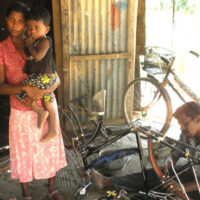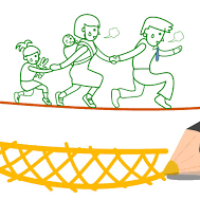Politics of Inclusion in Urban Development: The poor state of public participation
By Nirmani Liyanage, Research Professional, CEPA
On 24 May 2018
Citizen consultation conducted by the British planning authorities under the 1968, Town and Country Planning act made public participation part of the city development and planning process. Since then, the context, procedures and implications of public participation have been widely discussed and debated by academics across the world resulting in practitioners developing new approaches and methods of public participation to ensure inclusive development. According to top-level development decision makers in Sri Lanka, public participation is still required in development planning before decisions are implemented; and thus a ‘box to tick’. This was evident in the case of fisher communities who got affected by sand-mining for the Port City project. According to the representatives of the communities affected, ‘the officers came and told us the Port City is a good plan for everyone including fishermen. We asked them, if they know the kinds of fish that are present in this part of the Indian ocean or their breeding places. They said they have not been to the sea… we are not saying that they should go to the sea, but they can ask us… and they did not! They are doing the public consultations for the sake of doing it and to claim that they have consulted people!”
Events like the Meethotamulla garbage disaster, show the lack of empathy in decision-making resulted by public consultation processes like above. Making the public a part of decision-making is therefore urgent. This article presents a few key concerns relevant to public participation, especially in urban development.
Bridge or Wall?
As described by Fred Fisher (President, International Development Institute), public participation is meant to be a bridge between the state and citizens. Participatory exercises are similar to collective brainstorming that creates an inclusive urban future, conducted in an enabling environment with minimal power imbalance. Unfortunately, in practice, in Sri Lanka, it is more of a hurdle than a bridge between state representatives (i.e. urban planners, project planning and implementing officers) and the concerned people. I see at least five causes for this:
Public participation is done,
- very late in the planning process:
Sri Lankan planners and authorities mostly use the “rational comprehensive” (data survey-analysis-plan-implementation model; see Taylor, Nigel (1998). Urban Planning Theory since 1945. London: Sage Publications.) and “master planning” approaches to development. Both approaches were challenged globally for their inability to accommodate local values and inputs that might breach the linear process. In other words, there is no outside involvement built into these processes. Thus, public consultation within this approach is nothing but an empty ritual.
- as an empty ritual:
Even though public participation has become mandatory in Sri Lanka, decision making power on urban development has not been redistributed; it was further centralised recently when the UDA acquired the planning functions of local governments. The public consultation process followed by state planning agencies is more about justifying their projects. When there is a new policy or revision, a notice is published in three national newspapers, on the classified page which hardly grabs attention. The deadline is very tight, but no publicity is given through popular media. Some notices are shared on ministry websites, although there is no evidence of a substantial number of citizens reading ministry websites. Further, there is no follow-up with the people who have expressed their concerns, hence no accountability in the process of public consultation.
- in a technical language that is foreign to people:
In my experience as an urban planning graduate/researcher, public participation workshops in Sri Lanka aim to convince people of the expert’s plan. Our development agencies are programmed to see project-objectives as the only indicator of success and to see the end-result from the beginning. Within this framework, there is no room for any substantial inputs by people.
The project is explained in the expert language. Moreover, revision/correction of the plan due to outsider input is largely seen as a failure of the profession and agency. Most disagreements lead to conflicts with the public instead of being a humbling experience to the experts. Due to this mindset, the collaborative, corrective experience that experts can gain through decent public participation and the possibility of creating an output that is more acceptable to the users become missed opportunities.
- assuming the public as a homogeneous group:
Public consultation experts hardly acknowledge people as individuals; the diversity of society is ignored when soliciting public opinion. Such views not only legitimises pre-conceived development decisions, but also de-legitimises any suggestions made by individuals. It only scratchs the surface of diverse public opinion without really engaging the complexity of the views generated from multiple vantage points.
- conceptualized in a cultural vacuum:
Sri Lanka has experienced, different scales of public participation in multiple development projects such as Gal-Oya, Mahaweli and the Million-Houses programs. Sri Lanka, therefore has a wealth of locally developed knowledge, sometimes well documented by local and foreign scholars (See Learning from Galoya by Norman Upholf, 1996) but no evidence of learning from these, in school curricula or professional practice. In contemporary development planning, we simply import trends and methods from other countries. While useful to some degree, there is no evidence to suggest that foreign practices and methods employed are successful in Sri Lanka where more people discuss politics at handiyas while sipping tea than inside air conditioned halls or office rooms where the public are consulted.
Moments from public consultation session organized by CEPA to support the Ministry of Housing and Construction during the process of the revision of national housing policy, 2016/17
Hence, I ask myself: Can public participation be useful in a country where development is considered strictly a state’s job and development planning is an area for experts? The answer lies with the decision-makers and experts; the way they view development planning needs to change. If it can be viewed as a collaborative exercise where the state is a facilitator and an enabler, then there is some hope for true and dignified public participation.









